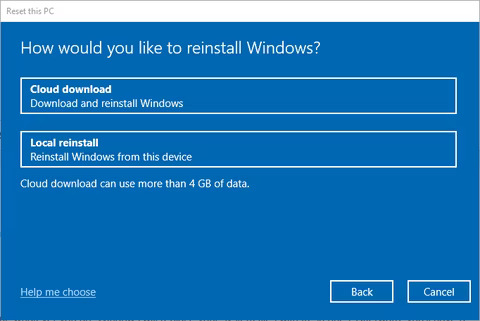When you're resetting your Windows 10 or Windows 11 PC, you'll have a choice between a "Cloud Download" and a "Local Reinstall." These options operate in slightly different ways, and they each have their own advantages and drawbacks. Let's explore the distinction between the two.
Both Options Result in Windows Reinstallation on Your PC
The "Reset This PC" function reinstalls the Windows operating system on your computer. You can choose to retain your personal files, delete them, or even clear your entire drive. Regardless of your choice, Windows will substitute your system files with new ones. Later on, you'll have a system that feels brand new, and you'll need to set it up and reinstall your applications once more.
[WARNING: Be sure to select the correct option! You wouldn't want to accidentally wipe out all of your files.]
For Windows 10, go to Settings > Update & Security > Recovery and click "Get Started" below "Reset This PC" to access this option. On Windows 11, you can locate it in Settings > System > Recovery > Reset PC.
"Cloud Download" and "Local Reinstall" achieve the same result: a fresh Windows 10 or Windows 11 system, akin to a factory reset for your PC. However, due to their distinct internal processes, one may be more suitable than the other depending on the circumstances.
"Cloud Download" Fetches System Files from Microsoft
Choosing "Cloud Download" prompts Windows to fetch updated system files directly from Microsoft's servers, which it then uses to reinstall the operating system on your computer.
The Reset This PC interface mentions that this download could exceed 4GB in size. If you have limits on your internet data or if your connection is slow, this could pose an issue. In such cases, you might find it better to opt for Local Reinstall instead.
This choice is crucial when your PC's system files get damaged. If the "Local Reinstall" option encounters a problem and can't reset your PC effectively, it's advisable to give Cloud Download a try instead.
Surprisingly, with a speedy internet connection, Cloud Download can be quicker than Local Reinstall. This is due to how Local Reinstall operates
"Local Reinstall" Relies on Your PC's Files
When you select "Local Reinstall," Windows will utilize the existing system files on your PC for the reinstallation of Windows.
Executing a "Local Reinstall" entails a bit more effort for Windows than it might initially appear. Windows needs to sift through its files, locate the original ones, and piece them together to form a new Windows system. Consequently, Local Reinstall can potentially take more time than Cloud Download, particularly if you have a swift internet connection.
According to Microsoft's Aaron Lower, the process of Local Reinstall can extend beyond 45 minutes as it involves "building a new version of Windows using the current setup." He mentioned this while highlighting the distinct operation of Cloud Download.
Local Reinstall comes in handy when you're dealing with restricted internet speeds, a sluggish connection, or when your device isn't connected to the internet. Additionally, it retains any Windows updates you've previously installed on your PC.
Moreover, in case the Windows system files on your PC are damaged, Local Reinstall might not be able to finish the process. If you're looking to reset Windows because of system issues, Cloud Download could be a more dependable option.
Choosing Between Local Reinstall and Cloud Download
For most standard PCs, both Cloud Download and Local Reinstall should function adequately. As long as you possess a swift internet connection without stringent download restrictions, and your PC isn't exhibiting signs of severe corruption, either option should effectively restore your PC to a fresh-like condition within a reasonable timeframe.
However, specific choices are more suitable for particular circumstances:
• If you enjoy a fast internet connection and data usage isn't an issue, opt for Cloud Download. It might be a time-saver.
• In case of a sluggish connection or if you'd like to steer clear of additional downloads, go for Local Reinstall. This way, you can bypass unnecessary downloads.
• If your PC is experiencing functionality issues or if you've attempted Local Reinstall without success, consider using Cloud Download.
No matter which option you go for, your PC will ultimately have a fresh Windows installation, bringing it back to a like-new state.
Are There Any Downsides to Using Cloud Download or Local Reinstall?
No, not really. Unless you mistakenly choose to erase all your files when you intended to keep them, the chances of a major problem occurring are quite slim.
If Local Reinstall encounters an issue, you'll receive a message indicating that there was a problem. It won't proceed with reinstalling Windows using corrupted system files. When the Reset This PC process finishes, it signifies that it executed correctly. Importantly, if the local installation encounters difficulties, you can always resort to a Cloud reinstall as a backup plan.
There's a chance that Cloud Download might encounter a hiccup if your internet connection drops, but this isn't likely to lead to major issues. You'll simply need to restart the process once your connection is back up. In the very unlikely event of a worst-case scenario, your files will still be on the drive — you'll just need to retrieve them.
If the Reset This PC process finishes, but you're still experiencing crashes, blue screens, or other system issues, it could indicate that your computer might be facing hardware difficulties rather than software-related ones.



Post a Comment